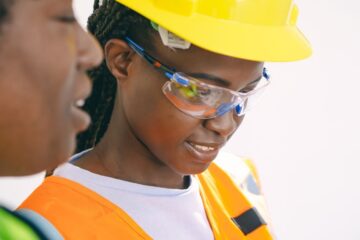Protecting your eyes is essential, whether you’re at work or engaging in recreational activities. Choosing the right protective eyewear is crucial for safeguarding your vision and preventing eye injuries in hazardous environments. In this comprehensive guide, we will explore the importance of protective eyewear, the different types available, and how to choose the right eyewear for your specific needs, whether for work or play.
Importance of Protective Eyewear
Protective eyewear is designed to protect your eyes from various hazards, including:
- Flying Debris: In industrial settings, construction sites, and woodworking environments, there is a risk of flying debris such as metal, wood, or glass fragments that can cause eye injuries.
- Chemical Exposure: In laboratories, chemical manufacturing plants, and other workplaces where hazardous chemicals are present, protective eyewear can prevent chemical burns and irritation to the eyes.
- Radiation Exposure: In industries such as welding, construction, and healthcare, exposure to UV radiation, infrared radiation, and other forms of radiation can cause eye damage if not properly protected.
- Impact and Blunt Force Trauma: During sports and recreational activities such as cycling, skiing, and basketball, the eyes are at risk of impact and blunt force trauma, leading to serious injuries such as corneal abrasions, fractures, and even blindness.
Types of Protective Eyewear
There are several types of protective eyewear available, each designed to provide protection against specific hazards:
1. Safety Glasses:
- Description: Safety glasses are a common form of protective eyewear designed to protect the eyes from flying debris, impact, and blunt force trauma.
- Features: They are made from durable materials such as polycarbonate or Trivex and feature impact-resistant lenses and side shields for added protection.
- Best for: Industrial settings, construction sites, woodworking environments, and sports activities.
2. Safety Goggles:
- Description: Safety goggles provide a higher level of protection than safety glasses, as they form a seal around the eyes to prevent liquids, dust, and chemicals from entering.
- Features: They are ideal for environments where there is a risk of chemical exposure or airborne particles.
- Best for: Laboratories, chemical manufacturing plants, and environments with airborne hazards.
3. Face Shields:
- Description: Face shields provide full-face protection against flying debris, chemical splashes, and other hazards.
- Features: They are often used in conjunction with safety glasses or goggles for added protection.
- Best for: Environments with high-risk activities such as grinding, cutting, and chemical handling.
4. Welding Helmets:
- Description: Welding helmets are specifically designed to protect the eyes from UV radiation, infrared radiation, and intense light produced during welding and cutting processes.
- Features: They feature a darkened lens that automatically adjusts to protect the eyes from glare and flash.
- Best for: Welding, cutting, and other activities with intense light and radiation exposure.
5. Sports Goggles:
- Description: Sports goggles are designed to protect the eyes during sports and recreational activities such as basketball, soccer, and skiing.
- Features: They are made from impact-resistant materials and feature padded frames and adjustable straps for a secure fit.
- Best for: Sports and recreational activities with a risk of impact and blunt force trauma.
Choosing the Right Protective Eyewear
When choosing protective eyewear, consider the following factors to ensure you select the right option for your specific needs:
1. Hazard Assessment:
- Identify the Hazards: Conduct a thorough hazard assessment to identify the specific risks present in your environment, including the type of hazards, the frequency of exposure, and the severity of potential injuries.
2. ANSI Z87.1 Certification:
- Look for Certification: Choose protective eyewear that meets the ANSI Z87.1 standard for impact resistance. This certification ensures that the eyewear has been tested and proven to provide adequate protection against impact and blunt force trauma.
3. Fit and Comfort:
- Comfortable Fit: Choose protective eyewear that fits comfortably and securely. The eyewear should provide a snug fit without causing discomfort or pressure points, and should not interfere with the fit of other personal protective equipment (PPE) such as respirators or hard hats.
4. Lens Material and Coatings:
- Durable Materials: Select lenses made from impact-resistant materials such as polycarbonate or Trivex, which are more durable and shatter-resistant than glass or plastic lenses.
- Additional Coatings: Consider additional lens coatings such as anti-fog, anti-scratch, and UV protection for added durability and visibility.
5. Style and Design:
- Suitable Design: Choose protective eyewear that is suitable for the specific tasks and activities you will be performing. Consider factors such as lens color, frame style, and ventilation options to ensure optimal comfort and visibility.
6. Compatibility with Other PPE:
- Ensure Compatibility: Ensure that the protective eyewear is compatible with other personal protective equipment (PPE) that you may be required to wear, such as respirators, hard hats, and ear protection.
Benefits of Protective Eyewear
Wearing appropriate protective eyewear offers several benefits, including:
1. Injury Prevention:
- Preventing Eye Injuries: Protective eyewear helps prevent eye injuries caused by flying debris, impact, chemical exposure, and other hazards, reducing the risk of serious eye damage and vision loss.
2. Enhanced Safety and Compliance:
- Meeting Safety Standards: By providing adequate eye protection for workers, employers can ensure compliance with safety regulations and standards, reducing the risk of workplace accidents and injuries.
3. Improved Productivity:
- Boosting Confidence: Workers who feel safe and protected are more likely to perform their tasks with confidence and efficiency, leading to increased productivity and morale in the workplace.
4. Long-term Vision Health:
- Preserving Vision: Protective eyewear helps preserve vision and reduce the risk of long-term eye damage caused by exposure to hazards such as UV radiation, chemical splashes, and impact trauma.
Proper Care and Maintenance
To ensure the effectiveness of protective eyewear, follow these care and maintenance practices:
- Regular Cleaning: Clean the lenses regularly with mild soap and water to remove dirt, dust, and debris.
- Routine Inspection: Inspect the eyewear for signs of damage or wear, such as scratches, cracks, or loose frames, and replace any damaged or defective components.
- Proper Storage: Store the eyewear in a clean, dry place when not in use, and avoid exposing it to extreme temperatures, chemicals, or harsh environments.
Conclusion
Protective eyewear is essential for safeguarding your vision and preventing eye injuries in hazardous environments. By choosing the right protective eyewear for your specific needs, whether for work or play, you can ensure optimal eye protection and safety. By understanding the different types of protective eyewear available, considering factors such as hazard assessment, ANSI certification, fit and comfort, lens materials and coatings, style and design, and compatibility with other PPE, you can select the right eyewear to protect your eyes and preserve your vision for years to come.


